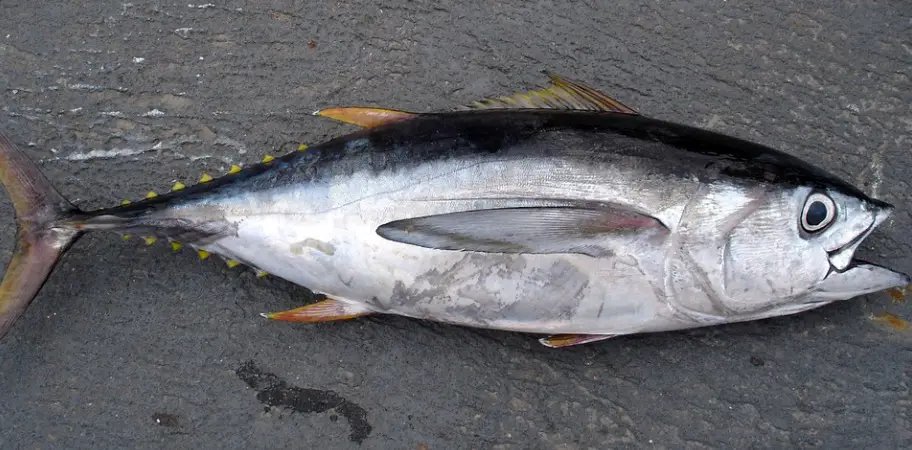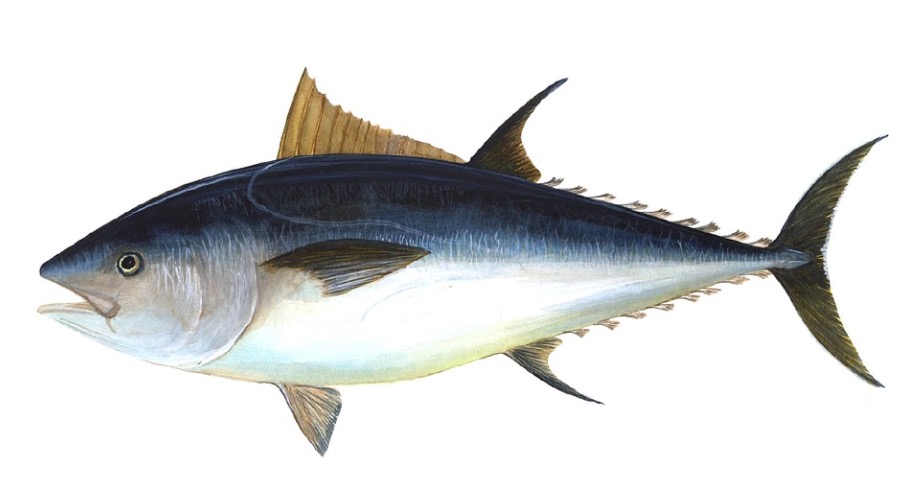Table of Contents
Bigeye Tuna: All You Need To Know
The Bigeye tuna is an epipelagic predator that belongs to the kingdom of Animalia, phylum Chordata, and class Actinopterygii. Its genus is Thunnus and its species is T. obesus. Its length is up to 2.5 m and it weighs up to 180 kg. It lives in the Indian, Atlantic, and Pacific Oceans, primarily offshore, with a lifespan of up to 9 years.
The bigeye tuna (Thunnus obesus) is a tuna species belonging to the Scombridae family. They may be found in tropical and temperate waters all throughout the world, and in many areas, they constitute a valuable commercial fishery.

Bigeye Tuna Description
The bigeye tuna is rhomboidal, or football-shaped, like other tuna. They feature huge mouths at the ends of their conical heads, as well as big eyes on both sides. They have long pectoral fins, similar to albacore tuna. They also have two dorsal fins and two anal fins, as well as a set of around 5-8 finlets between their tail fin and their anterior anal and dorsal fins on each of their dorsal and ventral sides, all of which are frequently coloured yellow or orange in mature individuals.

The dorsal or upper side of the bigeye tuna is charcoal, with a silvery-white hue on the flanks and ventral or bottom. They are huge fish that can grow up to 8 feet long and weigh up to 400 pounds, putting them in the middle of the tuna family in terms of size, with the Atlantic bluefin tuna being the largest.
Bigeye Tuna Habitat and Distribution
Bigeye tuna may be found in tropical and temperate areas across the world’s oceans. They are not, however, found in the Mediterranean Sea. Bigeye tuna, like other tuna species, are epipelagic. They spend a lot of time in surface waters, especially at night when prey is more plentiful.
They often dive to depths of up to 1,500 feet below the surface throughout the day. They frequently congregate with other members of their own species or with other fish of comparable size, such as tuna.
Bigeye Tuna Diet and Predators
The pursuit of prey is most likely the explanation for some tuna species’ deep dive habit. Bigeye tuna are quick, powerful swimmers who use their speed to attack a variety of food, including fish and crustaceans. They’ve also been observed hunting cephalopods, including octopus, cuttlefish, and squid.
All except the biggest predators, such as the false killer whale and perhaps orca, are capable of evading predation by adult bigeye. Sharks, such as the mako shark and the great white shark, can also feed on them. Other big predatory fish species, including larger tuna, may be added to this list by juvenile tuna.
Bigeye Tuna Reproduction
Bigeye tuna reproduce all year, but especially in the tropics. At higher latitudes, this tendency becomes more seasonal, maybe due to a more pronounced seasonal fluctuation in production in these areas. Bigeye tuna are broadcast spawners, which means that females will release their eggs into the water column, where they will be fertilised by sperm from males who do the same.
The embryo will grow into a larval fish as part of the zooplankton population after external fertilisation. It will grow into a tiny juvenile tuna and begin hunting smaller creatures soon after. Bigeye tuna may live up to 16 years, with sexual maturation occurring between the ages of two and four years.
Bigeye Tuna Conservation Status
Bigeye tuna is a prominent commercial fishery target, with up to 500,000 tonnes taken each year throughout the world. Management of these species is challenging because of their migratory character, since they need the permission and collaboration of numerous governments. Because one of the ecosystem’s apex predators has been removed, this intensive fishery puts pressure on the population, with numerous negative consequences at lower trophic levels.
In addition to overfishing, the species faces a threat from ocean warming caused by global climate change. The consequences of such changes are multifaceted and dynamic. One effect is a decrease or change in the marine phytoplankton population, which forms the foundation of the food chain upon which all other bigger creatures rely.
Tuna and other species may face increased pressure when primary production declines, which, along with overfishing, might pose a threat to the species’ survival. The IUCN Red List of Threatened Species now lists the bigeye tuna as vulnerable.
Fun Facts About Bigeye Tuna!
Tuna are an interesting and significant fish species. They are not only significant predators in the habitats they live in, but they are also vital commercially to fisheries all around the world. Although the bigeye tuna is one of the lesser-known tuna species, it is no less essential or intriguing, with a wealth of fun facts and insights to be discovered via its lens.
Uniquely Competent
Bigeye tuna, like other tuna species, are well-adapted to their surroundings and possess distinct physiological characteristics that enable them to survive in each of their niches. The bigeye tuna is exceptionally well adapted to low-oxygen conditions, with levels as low as 1.0 ml/L being tolerated. This is caused by the presence of a high quantity of haemoglobin in the blood, which allows it to bind to oxygen more quickly.
Because many deep, cold-water habitats are oxygen-depleted, the bigeye tuna’s adaptation permits it to reach foraging regions it wouldn’t otherwise be able to reach without its hemoglobin-rich blood.
Vertically Gifted
The physiological characteristics of the bigeye tuna are put to good advantage. Tunas have the most unique diurnal migration behaviour pattern among tuna species, moving into deep waters throughout the day and surface waters by night time. During the day, they will routinely go to depths of up to 1,500 feet, experiencing a temperature differential of up to 20°C from surface waters.
The average depth to which people dive varies throughout the world, suggesting that they may be looking for an ideal temperature range rather than depth. They may have to dive deeper in hot tropical locations to achieve these temperatures, but in colder temperate and subtropical seas, these temperatures will occur closer to the surface.
Although tuna may not find it especially advantageous to live in cooler waters, they may complete this movement in reaction to their food, which typically includes copepods such as squid, which are well known for their own diurnal migratory.
Same Same but Different
Because they are so closely related, all tuna species share some characteristics. As a result, it might be difficult to tell them apart. The bigeye and yellowfin tunas are perhaps the best examples of this. Both develop to be around the same size: bigger than albacore tuna but smaller than bluefin tuna. Both species have yellow fins and big eyes.
Both species are known in Hawaii as “Ahi,” the traditional term for tuna. However, there are some significant variations between the two species upon closer study. Bigeye tuna are more rotund, with a physique that is notably ‘plump.’ When compared to yellowfin and other tuna species, it has unusually big eyes and a huge skull.
Although the yellowfin tuna is more well-known across the world, bigeye tuna flesh is favoured for sashimi due to its slightly greater fat content. This example demonstrates how speciation isn’t always obvious. This is especially true when organisms continue to adapt and evolve in a changing and dynamic environment.
Hybridization may be feasible in certain situations due to comparable features and overlapping habitats, whereas in others, members of the same species may become geographically separated, eventually resulting in two different species with similar characteristics and a recently shared lineage.
Bigeye Tuna Citations
- A review of the fisheries, life history and stock structure of tropical tuna (skipjack Katsuwonus pelamis, yellowfin Thunnus albacares and bigeye Thunnus obesus) in the Indian Ocean. Adv Mar Biol . 2021;88:39-89.
- Development of a qPCR Method for the Identification and Quantification of Two Closely Related Tuna Species, Bigeye Tuna (Thunnus obesus) and Yellowfin Tuna (Thunnus albacares), in Canned Tuna. J Agric Food Chem . 2017 Feb 1;65(4):913-920.
- Collagen Extracted from Bigeye Tuna ( Thunnus obesus) Skin by Isoelectric Precipitation: Physicochemical Properties, Proliferation, and Migration Activities. Mar Drugs . 2019 May 1;17(5):261.







